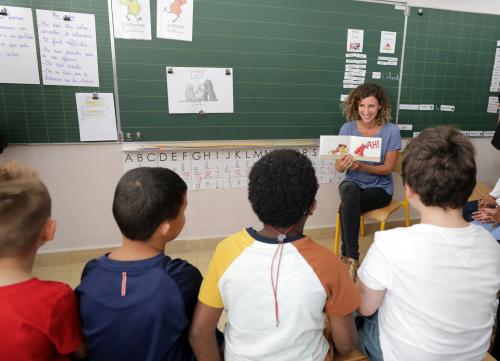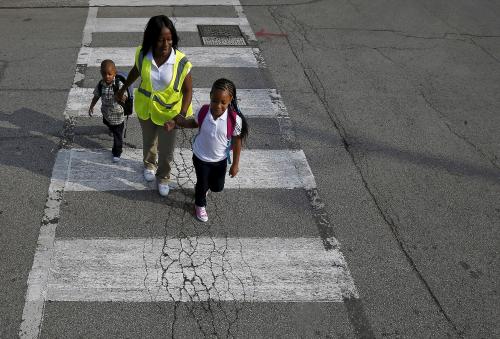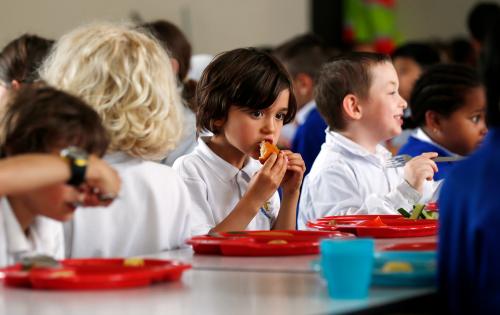Feeding hungry children is the primary purpose of America’s free (or reduced price) lunch program. Just over half of public school students are eligible for the program, ranging from nearly three-quarters of Mississippi students to just over one-quarter of students in New Hampshire. However, there is also a secondary use of the free lunch program: eligibility for free lunch is often the only way for states, school districts, and education researchers to identify low-income students.
Schools don’t generally have records of exact family income—it being mostly none of their business—so eligibility for free lunch status is usually the best proxy measurement anyone has to identify low-income students. But the real educational issue is less whether a family is having a bad financial year right at the moment and more what the family’s finances look like over the long run. So it makes sense to look at more than current-year free lunch eligibility. Katherine Michelmore and Susan Dynarski, in a paper titled “The Gap within the Gap,” demonstrate that using multiple year measures of free lunch status better identifies long-term, low-income students. Bottom line: students who are on free lunch status for several years come from lower income families than students who just happen to be eligible for free lunch this year. I’ll explain here the intuition of what’s going on (having benefitted from hearing Sue talk about the paper) in a rather wonky way. Below, I’ll explain why this should be a real action item for those who distribute money and resources among schools.
In the figure below I show (in blue) a pattern of fluctuating income that might be representative of a particular student’s family over the course of primary school. The shape is the same in the left and right panels. The red line shows the cutoff for free lunch. So in the years in which the blue line dips below the red, the student gets subsidized lunch. You will see that the student depicted on the left is eligible for free lunch only once. In contrast, the student on the right is eligible in most years. (In the real world, the cutoffs are 130 percent of the federal poverty line for free lunch and 185 percent of the poverty line to be eligible for a reduced price. The exact numbers depend on family size and are slightly different for Alaska and Hawaii, but for a mother with one child free lunch kicks in at a yearly income of about $21,000 and the reduced-price line is about $30,000.)

As a guess, the fact that the student at the right has more years eligible for free lunch was probably the second thing you saw in the figure. You likely noticed first that the wiggly blue line on the right is lower than the wiggly blue line on the left. And these two observations exactly explain the intuition of why students who are more frequently eligible for free lunch generally come from families with lower long-term income. If a high income family has a one-year dip in income, the odds are their income is still too high to qualify for free lunch. In contrast a family of more modest means is often near the eligibility border, so a dip down makes their child eligible. And a very low income family’s child is probably always eligible.
Michelmore and Dynarski look at a massive administrative data set from Michigan and show that the pattern described above is what we see in the real world. (Michelmore and Dynarski then go on to show that the number of years eligible for free lunch is a better predictor of educational outcomes than you can get using a single year.) In the next figure, I’ll show you what the relation between income and years eligible for free lunch looks like in nationally representative data taken from the Early Childhood Longitudinal Study.

Students and their families were surveyed five times from kindergarten through eighth grade, and one of the items surveyed was whether their children were eligible for free (or reduced-price) lunches. About half of students were never eligible. Other students were eligible between once and every year of the survey. The big income drop-off is, unsurprisingly, between the “never eligible” and everyone else (where income is measured as average income for a family over all surveyed years). But—just as in the first picture above—there is a large difference in average incomes between those eligible one year and those eligible every year. The gap is close to a factor of two. So if you want to identify students who come from very low-income backgrounds, look for those who are regularly on the free lunch program.
I promised an action-item suggestion above. There are, in fact, two.
Very frequently the only income data available to education researchers is whether a student is eligible for subsidized lunch. Researchers who are looking for a proxy for low socio-economic status should use all years, not just the current year. (Wonk side note: Matt Chingos points out that Congress has changed the technical requirements for establishing free lunch eligibility in ways that are good for kids but which may make FRPL eligibility much less useful for researchers in the future.)
The more important action item is for state and school district administrators who direct money in part toward low-income districts or low-income schools. You should strongly consider adjusting your formulas to put heavier weight on those districts and schools in which many students have a long history of being on free lunch. That’s a more effective way of getting money to the lowest of the low income.
Garrison Schlauch provided research assistance for this post.






Commentary
Making better use of data on free school lunches
August 31, 2016